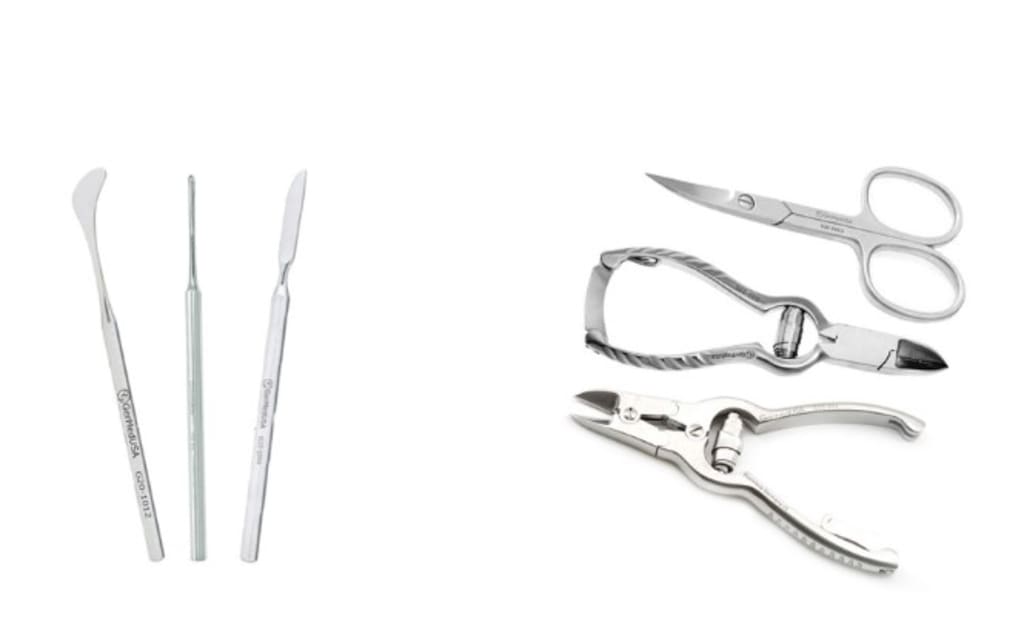The Impact of Podiatry Tools and Podiatry Surgical Instruments on Medical Care
Podiatry specialty covers comprehensive care of the feet and ankles. Podiatrists can enhance patient care by staying informed about the latest advancements in instruments and techniques.

Podiatry instruments are essential for proper foot care. These specialized instruments involve different products specially made for tasks within podiatric practices, ranging from basic foot service to intricate operations.
The global market for podiatry instruments is estimated to reach USD 3 billion by 2027.
This growth is due to the increase in the aging population, the incidence of foot and ankle disorders, and enhanced patient awareness. This informative writing delves into podiatry tools, emphasizing crucial components. Let's start!
The Importance of Podiatry Tools in Foot Care
There are many podiatry tools specifically made for the particular needs of foot treatment.
These tools make it possible for podiatrists to carry out accurate and successful procedures with optimal patient outcomes.
It’s important to have the right tools for diagnosing foot complications and performing minor or major surgery.
Key Podiatry Surgical Instruments
Understanding the primary podiatric surgical instruments is essential for those involved in podiatric care.
Here are some of the most commonly used poditary tools:
1. Forceps
Some of the forceps that are known include tissue forceps, splinter forceps, and hemostatic forceps.
They are used for gripping, holding, manipulating tissues, and more stuff.
2. Nail Splitters and Nippers
Their main purpose is to trim thick nails and pull out nails if needed.
They are very important in dealing with ingrown toenails and any other nail conditions.
3. Curettes
The small, scoop-shaped instrument removes dirt and cleans wound areas the best.
They are also helpful in eliminating calluses, corns, and dead tissue.
4. Rasps and Files
These are used to smooth out rough bone surfaces and shape bones during surgery.
They are commonly used in procedures addressing bone spurs and other deformities.
5. Retractors
Instruments like skin hooks and Senn retractors are used to hold back tissues, providing better visibility and access during surgery.
Medical Podiatry Tools for Routine Care
Apart from surgical instruments, various medical podiatry tools are essential for routine care and diagnostics:
- Podiatry Chairs and Examination Tables
Adjustable, they languish in leisure, which makes ill people easily and correctly placed throughout the interview and curing period.
- Diagnostic Ultrasound Devices
Their main use is to see the insides of the foot and ankle, which will help in coming up with the right treatment plan for a disease diagnosis.
- Diabetic Foot Care Kits
A specialized kit used to diagnose neuropathy and other complications in diabetic patients contains monofilaments, tuning forks, and other tools.
Specialized Podiatry Procedures and Tools
Certain podiatric conditions require distinct tools and techniques.
These examples illustrate specific procedures and the respective tools:
- Bunion Surgery
It commonly requires scalpels, a bone saw, and orthopedic screws to reposition the toe joint.
- Ingrown Toenail Removal
It is utilized for gentle and purposeful avulsion of the problem nail piece using nail nippers, forceps, and curettes.
- Plantar Fasciitis Treatment
This might include utilizing orthotic apparatus, healing with ultrasound machines, and cortisone injections.
Tips for Maintaining Podiatry Tools
It is very important to properly maintain podiatry tools so that they last long and work well.
The following are some common tips:
- Regular Cleaning
- Proper Sterilization
- Routine Inspection
Choosing the Right Podiatry Tools
Selecting the appropriate podiatry tools involves considering several factors:
Quality and Durability
High-quality materials ensure longevity and reliable performance.
Ergonomic Design
Tools should be designed for ease of use, reducing hand fatigue during prolonged procedures.
Sterilization Compatibility
Instruments must withstand sterilization processes to maintain hygiene and prevent infections.
To Conclude!
Long story short, the podiatry specialty covers comprehensive care of the feet and ankles.
Podiatrists can enhance patient care by staying informed about the latest advancements in instruments and techniques.
Staying updated on industry developments ensures the best possible care for patients.
They are a reliable source of high-quality podiatry tools, ensuring reliability, durability, and excellence in podiatric care.
FAQs
Which instruments are most critical for a new podiatry clinic?
Scalpels, nail nippers, forceps, curettes, and diagnostic devices are some of the most crucial tools for new practices in podiatry.
How frequently must instruments in podiatry be sanitized?
You ought to sterilize the podiatry equipment after every use to prevent cross-contamination.
Why is it important to use high-quality podiatry tools?
High-quality podiatry tools are necessary to ensure precision, durability, and safety in procedures. They decrease the risk of complication, thus improving outcomes.
About the Creator
Enjoyed the story? Support the Creator.
Subscribe for free to receive all their stories in your feed. You could also pledge your support or give them a one-off tip, letting them know you appreciate their work.





Comments
There are no comments for this story
Be the first to respond and start the conversation.